FAQs on African Cichlid
Identification 3
Related Articles: African Cichlids, Malawian
Cichlids: The Mbuna and their Allies By Neale Monks, The Blue
Followers: the Placidochromis of Lake Malawi by Daniella
Rizzo,
Related FAQs: African Cichlid ID 1, African Cichlid ID 2, African Cichlid ID 4, African Cichlid ID 5, African Cichlids, African Cichlid Selection, African Cichlid Behavior, African Cichlid Compatibility, African Cichlid Systems, African Cichlid Feeding, African Cichlid Reproduction, African Cichlid Disease, Cichlids of the World, Cichlid Systems, Cichlid Identification, Cichlid Behavior, Cichlid Compatibility, Cichlid Selection, Cichlid Feeding, Cichlid Disease, Cichlid Reproduction, & Malawi Cichlid Systems, Tanganyikan Systems,
|
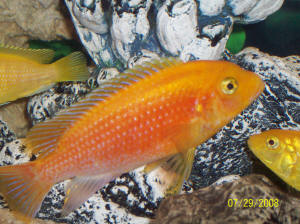
|
|
Cichlid Identification
Malawi Cichlid ID -- 11/07/09
Hello Crew, I was wondering if you could confirm the species of
Cichlid in the attached photos. I purchased them as juvenile
Rusty Cichlids (Iodotropheus sprengerae). Everything I had read
about them indicated they were relatively peaceful (for Mbuna),
and would do well with Labidochromis caeruleus and Pseudotropheus
acei. However, before I even let them out of the bag they were
fighting amongst themselves; several months later as young adults
(one male/two females), the largest male and female wreak havoc
in my 50-gallon Mbuna tank (the other female Rusty is an
inoffensive creature who has remained much smaller than her
colleagues). The large female Rusty (who is much more orange in
colour than the other two) was dominant until she had a terrific
fight with the male -- scales flying, mouths white. Then they
spawned a couple of weeks later and the male harassed her until
she swallowed her eggs, and constantly beats her up (you can see
her tattered fins in the photos). He has now begun tormenting
every other fish in the tank, even those much bigger than he.
When I temporarily removed him, the female took up where he left
off; especially targeting the Labidochromis caeruleus. I plan on
removing these two rogues, but I was wondering if these really
are Iodotropheus sprengerae, or if I have a couple of impostors
in my tank.
Tank parameters:
50 gallon breeder
pH: 8.0 - 8.2
Ammonia: 0
Nitrite: 0
Nitrate: 10
kH: 9 dH
gH: 13 dH
Weekly water change: 40%
Filtration: Eheim 2213 Classic; Aquaclear 70
Lots of rockwork and live plants (Hornwort, Anubias, Rotala
rotundifolia, Vallisneria), so there are lots of hiding
places.
Tankmates: Labidochromis caeruleus (1M/3F) and Pseudotropheus
acei (1M/3F).
Thanks so much! Carla
< The fish in the photos is neither a rusty or a yellow lab. I
suspect they were trade-ins. They look like a cross. This is very
common in mixed species tanks where fish are allowed to bred with
dominant fish in the tank.-Chuck>
|
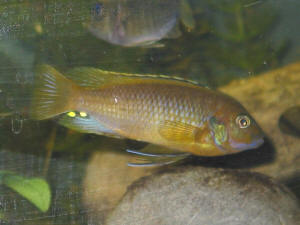 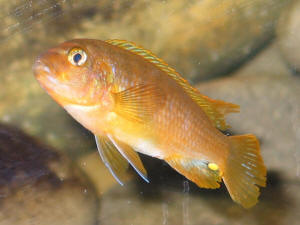 |
|
Re: Cichlid Identification
Malawi Cichlid Cross 11/8/09
Thanks very much, Chuck, I suppose that explains the
unpredictable behaviour. It's all very strange; my LFS
supposedly ordered them in for me as Rusty Cichlids (Iodotropheus
sprengerae), which I specifically wanted for my tank to *avoid*
hybridization (since they are the only species in that genus and
unable to hybridize with other Cichlids). I will show this e-mail
to my LFS and try to return them (even though several months have
passed), and perhaps peace will reign in my tank at last. I
suppose this is a prime example of why hybrids are so detrimental
to the hobby!
Thanks again, Carla
< Don't use the genus name on a cichlid to determine its
potential to cross. The names given to cichlids usually have
nothing to do with their DNA but are named due to physical
differences like in their teeth. Many different Malawi cichlid
genera are quite capable of crossing in artificial conditions
like an aquarium.-Chuck>
|
|
Malawi Cichlid ID 8/13/2009
Hi, I recently purchase 2 new cichlids to put into my tank. I was
curious as to whether you could tell me what species it is. I
attached a photo
Thank you, Mike Shatswell
< You have a Melanochromis johanni male.-Chuck>
|
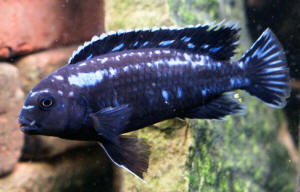 |
|
id of cichlid 8/3/09
Malawi Cichlid ID's
I was trying to ID this cichlid of mine.
The other head in pic I believe is a bumble bee cichlid
Thanks Dave
< The head shot is a Pseudotropheus crabro, commonly called
the Bumble Bee cichlid due to its immature and female coloration
resembling a bumble bee. The larger yellow cichlid is a male
Pseudotropheus lombardoi or commonly called Kenyi in the hobby.
Females and young ones are a light blue color.-Chuck>
|
 |
Red Top Cobalt ID --
7/18/09
Dear Crew Member,
I'm having a "moment," somewhat like an argument with
myself. After so much confusion and finding I can provide no clear
answer, I turn to my friends at WWW. This issue will also serve as a
classic example why taxonomic nomenclature should be used exclusively
when referring to living organisms.
I recently got back to keeping Malawian Cichlids (already have two reef
tanks). I purchased two individuals a few days ago tagged as Mbunas
commonly referred to as Red Top Cobalt Zebras, formerly Pseudotropheus
zebra, now reclassified as Metriaclima sp. Fine...my problem deals with
the "sp." In the genus Metriaclima I find several species
that could possibly match the fish I purchased. There is Metriaclima
callainos, sometimes commonly called the Cobalt Zebra, but without the
red-orange dorsal. However, M. pyrsonotos
is referred to as a Red Top Zebra and is a visual match, red-orange
dorsal and all. However, since these have been identified as two
distinct species I must assume that the "Red Top" is not just
a variant of the Cobalt, correct? Then, I also find an individual
described taxonomically as M. emmiltos and commonly called a Red Top
Zebra, although this designation was somewhat harder to uncover.
Pictures I find of this species also match my specimen. To confuse
matters further, I also have one individual commonly referred to as an
Albino Red Top Cobalt Zebra, also purchased as Metriaclima
sp. (I'll send along helpful pix once I find the camera to PC
cable.
My questions are these:
1) Can a Red Top Cobalt Zebra be matched to M. callainos, M.
pyrsonotos, M. emmiltos, or some other scientific name?
< You have a Metraclima pyrsonotus.>
2) Does the red-orange finnage alone comprise enough of a physiological
difference to demand a separate species classification?
< Not usually. Morphological differences in teeth and mouth
structure are the usual indicators of different species.>
3) Would the albino simply be a variant of one of these or is it a
separate and distinctly classified species? Or, what is it?
< Albinism is simply the genetic lack of pigment and can possibly be
found in any species.>
As always, thanks for your dedication and support. Regards, from
David Bell
< Thank you for your kind words.-Chuck>
|
Cichlid question
Cichlid ID 5-7-09
I am very sorry to disturb you, I have had a particular cichlid
about 3 inches whose name I cannot find..
I've tried google, yahoo and even aquahobby.com but I'm
still unsuccessful in finding the name of this African
Cichlid...
Can you please identify and give me information on the
cichlid?
Thank you for your co-operation..
< Looks like a Placidochromis miloto or more commonly called a
VC-10. It is either a young male or a female. It may turn blue if
it is a male. In the wild they get big lips. In the aquarium this
doesn't happen too often.-Chuck>
|
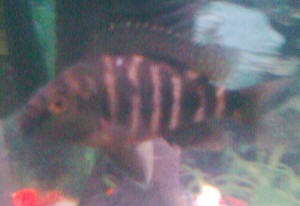 |
|
Cichlid ID & tank (Chuck, cichlid ID?)
4/7/09
Neale, it's me again!
<Hello Summer,>
I've been researching the Pseudotropheus demasoni, and I love
the look of this dwarf cichlid. I've read a few online
recommendations that they should be kept in a minimum of 6 or 12.
What's your view on the minimum number I should add to my
tank?
<Does rather depend on the size of the tank. But assuming a
reasonable amount of space, like all Mbuna, colonies are the
ideal. Strictly speaking, you want at least one male per 2-3
females, since the males are primarily aggressive to one another,
whereas the females are basically peaceful.>
Also, I said I have yellow-tail acei, but when I was in Aquatic
Design Centre yesterday, I saw their labels and now am not sure
what my fish are!
<I must confess to occasionally having seen mislabeled and
hybrid fish in this store, so be careful.>
I've attached a photo. Can you please let me know what type
of fish I have?
<Could be a rather dull-coloured Pseudotropheus acei, but
could equally easily be some sort of hybrid. For African
cichlids, the best place in London is probably Wildwoods out in
Enfield (Zone 6, Crews Hill train
station).>
Muchas Gracias,
Summer
<Do remember you can't mix different Pseudotropheus in one
tank safely:
they will certainly fight and usually hybridise. Despite their
wide availability, I consistently recommend people against buying
Pseudotropheus, at least initially. Cheers, Neale.>
|
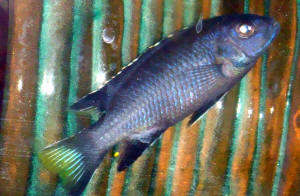 |
|
Re: Cichlid ID & tank
Malawi Cichlid ID and Questions... Chuck's bit
4/9/09
Neale, it's me again! I've been researching the
Pseudotropheus demasoni, and I love the look of this dwarf
cichlid. I've read a few online recommendations that they
should be kept in a minimum of 6 or 12. What's your view on
the minimum number I should add to my tank?
<This little cichlid carries a big stick. For its size it is
very aggressive and a group of at least 6 is recommended.
Assuming a 50/50 sex ratio, this will leave you with 3 females
and 3 males. One dominant male will chase or kill the other males
if they are not removed. This will leave you with one dominant
male and three females. The harem will keep the male from
continually chasing a single female and will spread the
aggression out among the others. More will give you a good chance
of successful breeding.>
Also, I said I have yellow-tail acei, but when I was in Aquatic
Design Centre yesterday, I saw their labels and now am not sure
what my fish are!
I've attached a photo. Can you please let me know what type
of fish I have?
< It could be an acei. This is one of the least aggressive of
the Mbuna types so they don't always color up to their best
potential while being dominated by other more aggressive
cichlids.-Chuck>
Muchas Gracias, Summer
Re: Cichlid ID & tank 4/9/09
<Chuck, any idea what the fish in this photo might be? I
suggested possibly a poor quality Ps. acei, but just as likely a
hybrid. Can you do any better? Cheers, Neale.>
< Neale, I totally agree with your conclusion. When kept with
other more aggressive cichlids they don't color up much. The
Florida fish farmers rarely select for color. My guess would be a
poor quality acei in a tank where he is not the dominant fish in
the tank. Since it sounds like he just got him it is unlikely the
fish is going to show any color for awhile.-Chuck>
<Thank you for this Chuck. Cheers, Neale.>
Re: Cichlid ID & tank
Ps. DeMasoni Questions 4/11/2009
Chuck, thanks for your follow up information! So if I add 6
Pseudotropheus demasoni (which I keep calling demon-osi for some
reason, maybe because I have Satan), and assuming a 50/50 male to
female ratio, I could expect two male deaths?
< Ps. demasoni is actually named after a Friend of mine, Laif
DeMason, owner of Cichlid News magazine and Old World Exotic Fish
farm. The dominant male will pick and chase the other males. They
can soon be found with torn fins and can be removed before there
is any more bloodshed.>
Oh how sad that would be. I've read that it's difficult
to sex them. Do you think I could determine sexes, and identify
the dominant male in hopes of returning the other two males to
the LFS?
< Males are darker than the females. Their black bars are
wider and they can get slightly larger than the
females.-Chuck>>
The 'possible' acei cichlids in my tank are the most
peaceful, even more so than the Yellow Labs.
Neale, my garden and vegetables are growing like crazy! I
attribute their proliferation to my aquarium "super
juice". My neighbour agrees and thanks me for a constant
supply. Kind regards,
Summer
|
|
Need help identifying cichlid 11/23/08
Hi, I was wondering if you guys could help me identify this
Cichlid.
Sorry for the bad photo quality, as I was only using my cell
phone to take the picture.
I'll do my best to describe the fish to you though;
It's body is mostly a somewhat dull yellow, with thick, dark
black stripes on it, and black covering most of it's
head.
It's head also has a slight bluish color around the black on
it's face.
The fin's all have dark black stripes on the tops of them,
with yellow in between.
I know it's from Lake Malawi, but I can't remember the
actual name of the
fish, since the guy at the retailer was telling me so many Latin
names, I had a hard time keeping up.
I hope this description is enough for you to help me identify the
fish.
Best Regards,
Patrick
<Mmm, might be a male Pseudotropheus saulosi... the yellow
though... perhaps this is a (all too common) hybrid Mbuna. Bob
Fenner>
Need help identifying cichlid
10/23/08
Cichlid ID From Lake Malawi
Hi, I was wondering if you guys could help me identify this
Cichlid.
Sorry for the bad photo quality, as I was only using my cell
phone to take the picture.
I'll do my best to describe the fish to you though;
It's body is mostly a somewhat dull yellow, with thick, dark
black stripes on it, and black covering most of it's
head.
It's head also has a slight bluish color around the black on
it's face.
The fin's all have dark black stripes on the tops of them,
with yellow in between.
I know it's from Lake Malawi, but I can't remember the
actual name of the fish, since the guy at the retailer was
telling me so many Latin names, I had a hard time keeping up. I
hope this description is enough for you to help me identify the
fish.
Best Regards, Patrick
< Do a Goggle image search on Pseudotropheus flavus and see if
the images match you fish.-Chuck>
|
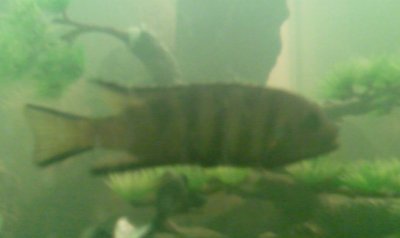
Re: Need help identifying cichlid
11/25/08
Cichlid ID From Lake Malawi II
Thanks a lot, I'm not 100% sure that's what my fish is,
but that is definitely the closest I've seen to what my fish
looks like. Although Mine has a little more black in it, and the
yellow isn't quite as prominent, from the looks of it,
that's probably the breed of fish I have.
Thanks for the help,
Patrick
< The amount of black can be quite variable from fish to fish.
The yellow coloration can be enhanced with diet, water quality
and lighting. Glad we could help out.-Chuck>
|
|
What kind of Cichlid is this? -- 10/02/08 Cichlid
ID Greetings (pass my hello on to Neale if he's
around) I was wondering what kind of cichlid I have. Attached
is a photo. If this picture is not good enough, I will try to
take another. Thank you! Skye < The cichlid in the photo you
provided is definitely from Lake Malawi. It is called an Mbuna
by the locals for all rock dwelling cichlids from that lake. It
looks like it could be in the genus Pseudotropheus/Metriaclima.
But looking at the large mouth makes me think it could be
Petrotilapia. The later gets pretty big and gets very
aggressive. With a better picture I might be able to further
define the species.-Chuck>
|
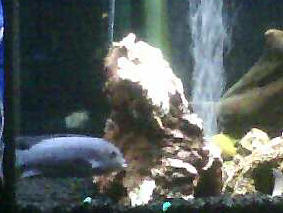 |
|
Re: What kind of Cichlid is this? 10/2/08
Cichlid ID II, With Much Better Picture
Thanks. Attached is another picture of him (I'm assuming
it's a him - I have no idea how to tell gender on this type
of fish yet). He is about 5" long and around two years old.
I rescued him from a friends tank, as a more dominant fish was
picking on this beautiful one. His color has become more vibrant
in the two weeks I've had him. Not much else is know about
him. My friend thinks this fish is a "mutt/Heinz 57"
variety. Your thoughts with this new picture?
< The new picture is much better. You have what is commonly
called a Cobalt Blue, Metraclima callainos. Probably the original
founder stock came from Nkhata Bay.-Chuck>
|
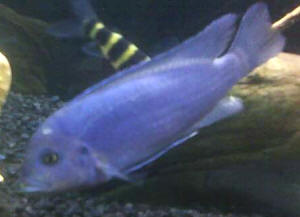 |
| Hello, I was wondering if you could identify
this fish... This fish was sold to me at PetSmart as a "yellow
lab". -- 7/30/08 <It isn't.> When these fish
were small, I thought I was getting two female yellow Labidochromis
caeruleus, but the two have spawned. <Oh dear.> I thought
yellow labs only came with black stripes on the top fin, and this
fish appears to be yellow-orange. I have not seen these fish on any
other website, so I was wondering if you could help me identify it.
<These are some sort of Maylandia, perhaps Maylandia estherae or
an orange form of Maylandia zebra... or for that matter some sort
of hybrid. One should never, ever by Mbuna that aren't clearly
identified.> Thank you so much for your help. They also have
produced a few offspring with black stripes along the top fin.
<Mbuna hybridise very readily unless you take care to keep
species that won't hybridise (e.g., by choosing species from
different genera, i.e., one species of Labidochromis, one species
of Iodotropheus, and so on). Please please please do not give away
or sell fry you suspect may be hybrids -- this is a blight on the
hobby and one of the most irresponsible things any aquarist can do.
The problem is hybrid fish are by their nature unpredictable in
terms of behaviour, size and colouration, making it impossible to
create a tank with sensible, carefully considered choices of
species. If you have excess fish, please destroy them painlessly
(see the Euthanasia FAQ here at WWM for tips). Cheers,
Neale.> |
|
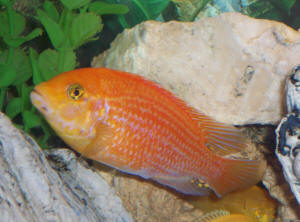
| Hello, I was wondering if you could
identify this fish... 7/30/08 Cichlid ID This fish
was sold to me at PetSmart as a "yellow lab". When
these fish were small, I thought I was getting two female
yellow Labidochromis caeruleus, but the two have spawned. I
thought yellow labs only came with black stripes on the top
fin, and this fish appears to be yellow-orange. I have not
seen these fish on any other website, so I was wondering if
you could help me identify it. Thank you so much for your
help. They also have produced a few offspring with black
stripes along the top fin. <The is a Pseudotropheus
species of some sort. It could be a cross between a couple
different species. Because of the color I believe it is some
sort of cross developed in Asia and is not a true species
found in the wild. These cichlids are capable of crossing
with almost any other Mbuna type from Lake Malawi. This makes
them excellent candidates for making "designer
cichlids".-Chuck> |
|

|
About that Maylandia...I do believe Neale is correct!
8/1/08 Hello there! I just thought I would add this little
note. <Hello again Nicole!> I was up reading the FAQs early
this morn after having missed a few days, and I saw Neale's
answer to the query about the fish that was sold to someone,
mistakenly, as a yellow lab. <Yep, I think we're agreed on
this!> I found this article:
http://www.gcca.net/fom/Maylandia_estherae.htm And do believe
that the picture on it shows a fish that looks spot on like the
picture provided. <Certainly my gut feeling. But the problem
is that there are so many hybrids that unless you buy from a
reputable retailer, you don't always know what you're
getting.> I just thought I would add that I have a brood of
African cichlids that crossed (a yellow Labidochromis caeruleus
and a blue Pseudotropheus socolofi) and, except for the deep
orange, this fish looks very similar to mine. <Not encountered
this hybrid. Thanks for the heads-up.> So it could possibly be
a mix of a yellow lab and a blue Pseudotropheus, but the
Maylandia seems much more likely. <I would tend to agree.>
I had never heard of this fish before...thanks for introducing
this species to me, Neale! <It's a nice fish.> Rest
assured my fish are never being given away or traded in, I am
embarrassed enough that I allowed this to happen when I was less
experienced. <We all make mistakes like this. The problem is
that so many people don't care anymore, and the market is
flooded with hybrids. That's undermined the Malawi cichlid
hobby. When you think about Malawi cichlids, they include some of
the most amazing fish with the brightest colours -- even compared
with marine fish! That's why I get sad when I see hybrids --
I know that lots of aquarists are going to end up with
muddy-coloured, unpredictable fish and wonder why people like me
enthuse about Mbuna.> Take care, and have a lovely weekend.
Nicole <Likewise Nicole and thanks for writing. Cheers,
Neale.>
|
Red Zebra and a Kenyi I
think... Af. cichlid ID... 5/17/08 Hello all at WWM... I hope
all is well for you today... <Thank you> I once wrote in about
Jewel cichlids and for a quick update on them, all is well... I have a
bunch of babies swimming around eating flake food and seeming happy and
the momma just laid a bunch of eggs again. I don't guess I lowered
the water temp. enough :) but oh well I will take care of it lol...
Since I spoke to u last, I had 2 unknown cichlids die in my 55 gallon
tank. I set up my little 10 gallon tank for a hospital tank and tried
to survive the 2 with no luck... I suspected aggression since the other
fish seemed fine. That left my 55 almost empty, it had and still has a
large Electric Yellow, and a Nimbochromis ( the giraffe looking one) I
don't think the 2 are really supposed to be good tank mates, but
all seem well with them right now. Here's the problem... I
purchased 2 new "African Cichlids" at Wal-Mart, well
that's all that they list them as here and I get to play detective
to see what I have when I get them home... I think I have correctly
identified the first as a Red Zebra and the other as the Kenyi. <Or,
too likely, crosses...> The Kenyi is really pretty golden yellow
with a hint of pinkish purple on its back area with its black stripes.
I love this fish and he's extremely active...The Red Zebra fish is
fairly active but I since I got him I have noticed him beginning to
bounce off the tank decor. Water chemistry is set up as hard/alkaline
water and the nitrates, nitrite and ammonia are all good... 10, 0,and 0
... I may have that backwards since I am not looking at my cards... The
Zebra is also showing signs of red gills... I moved him to hospital
tank and gave him a parasite treatment. Gills still red. He eats well
and seems active still but he kind of swims a bit funny at times, kind
of like he's gonna turn and go back the other way and then whips
back around and stays on same path he was traveling... Don't know
much about this...any advice? Fish has no spots or visual anything to
help with diagnosis, but I definitely don't think all is well with
him for some reason. Also when I purchase new fish (if I ever do again,
since I have so many Jewel babies) how long do u suggest that I keep
new fish from old fish before risking infecting my whole tank.
<Posted... a good two-three weeks is about right> And if you
recommend I treat this Red Zebra again should I go ahead and treat the
whole 55 gallon tank even though they seem fine at this point? Any
thing u can tell me is greatly appreciated about this and any pointers
on the Kenyi will also be welcomed! <Read on WWM... African
Cichlids, Disease...> OH and one last question, how long until my
Jewel babies begin to get any color? <A few weeks to a couple of
months> Just curious about that, not drastically important. I would
really like to know what color they are gonna be, so I can pick which
ones will become feeder fish... I know sounds terrible but I am over
flowing in babies and running outta homes for them...Have a great day
and many thanks for such a great site! ~ JerrieSue ~ <Keep reading
JS... you'll do fine. Bob Fenner>
|
|

